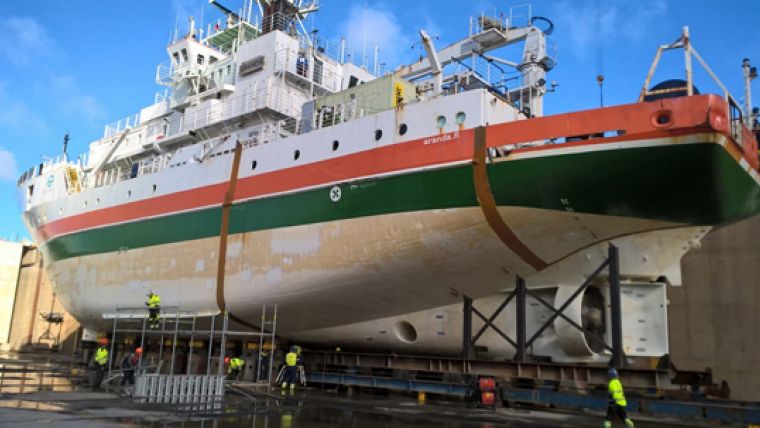Marine Research Vessel 'Aranda' to be Refurbished
The almost-30-year-old 'Aranda' will undergo a renovation at the Rauma Marine Constructions (RMC) shipyard in Rauma, Finland. The modifications will involve a seven-metre extension to the vessel, which will become more environmentally friendly. The refurbishment of the research vessel requires special expertise, which in the best-case scenario may result in more work for Finland.
The renovation and modification of Finnish Environment Institute SYKE's marine research vessel, Aranda, has begun at the Rauma Marine Constructions shipyard in Rauma. The Aranda arrived at the shipyard at the end of July 2017 and will be ready for action again next spring.
The marine research vessel Aranda is a key part of Finland's national marine research infrastructure. Work performed on board produces research material essential for marine research and for monitoring underwater biodiversity and the environmental status of the sea. The Aranda is used by institutions such as the Finnish Meteorological Institute and Natural Resources Institute Finland, in addition to SYKE. In recent years, the SMHI, the Swedish Meteorological and Hydrological Institute, has also used the Aranda in its Baltic Sea monitoring missions.
The purpose of the Aranda's refurbishment and modernisation is to ensure the ship's ability to function until the 2030s while reducing its environmental impact and operating costs. The refurbishment involves adding a new block in the central section and redesigning both the aft and after-deck. The additional metres will facilitate the expansion of research and laboratory spaces and the transition to a completely electronic power transmission in accordance with new research requirements.
Hybrid Propulsion
The refit will enable the Aranda to run on biodiesel all year. In addition, the vessel will be able to travel short distances on battery power only, which will reduce emissions and bring down the noise level caused by the ship when at sea. This is a major improvement for the marine organisms studied, it is also important for the research itself since it will make hydroacoustic surveys easier to perform.
Originally built in the Helsinki shipyards of Turun Laivateollisuus and Wärtsilä, the Aranda was originally commissioned in 1989. The vessel is primarily designed for round-the-year research activities in the Baltic Sea, as well as for studying polar regions. In addition to the Baltic Sea, the Aranda has operated in both Antarctic waters and the Arctic region.
The ongoing reform will improve the Aranda's potential for marine research in cold sea areas in particular, since only a few research vessels of the same size in Europe can endure Arctic conditions. The new hull shape and renewed power transmission will enable the Aranda to navigate better than before, both in Baltic Sea ice and by the expanse of ice in the Arctic Ocean.
The renovation of the ship is a pleasant challenge for both the RMC shipyard and Finnish expertise in special vessels. The lifetime of research vessels is generally longer than that of cargo or passenger ships. Due to the growing challenges involved in research activities, research vessels are often refurbished and modernised at some point.
One of the goals of the Aranda's renovation is to further strengthen the know-how of Finnish ship design and construction. The renovation of the Aranda combines the expertise of the marine engineering company ILS Oy, RMC and SYKE into Finnish top know-how. Several research vessels around the world are due for renovation and the Aranda's remodelling is being closely monitored internationally.














